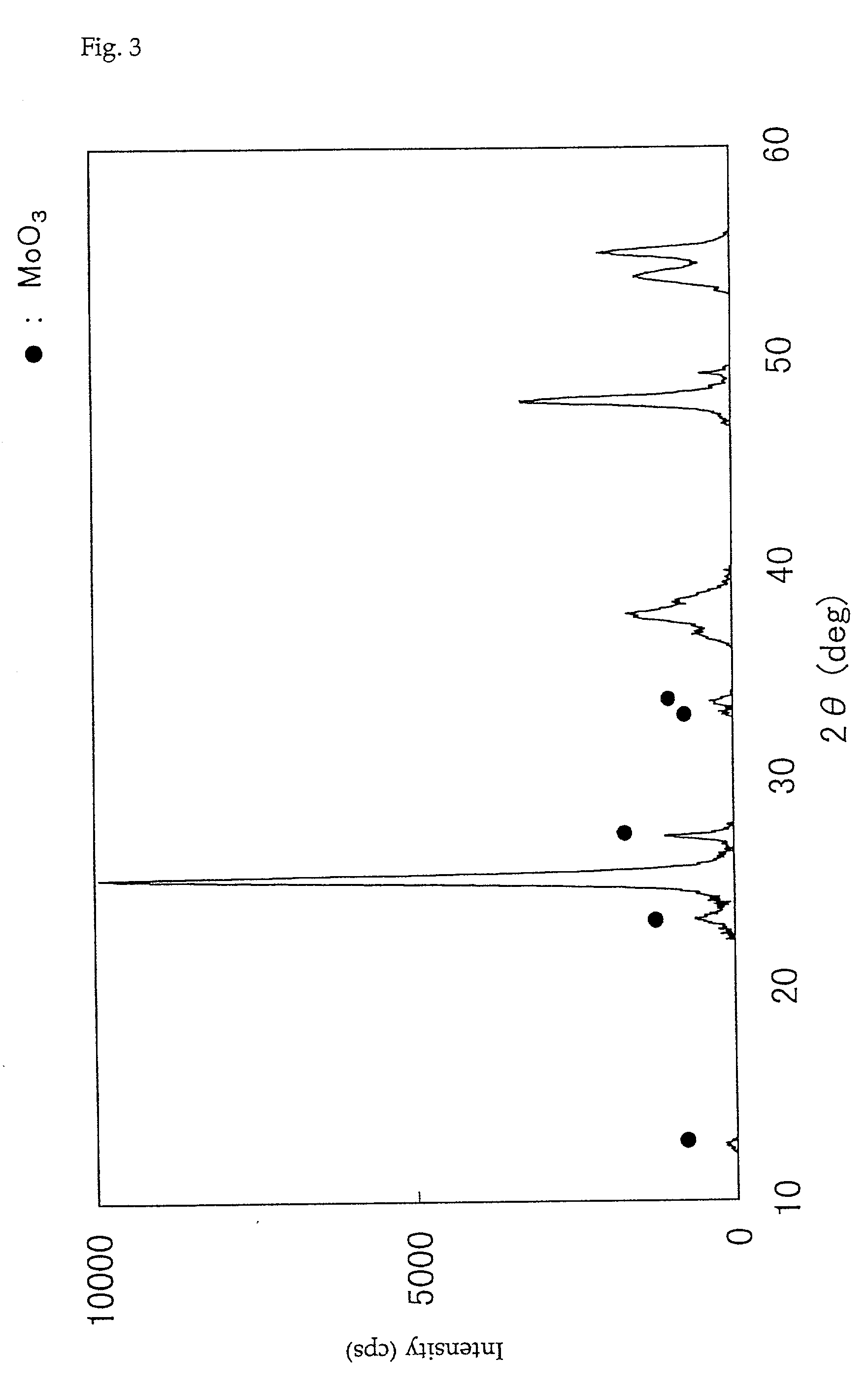Catalyst for purification of exhaust gases, production process therefor, and process for purification of exhaust gases
a technology of exhaust gas and catalyst, which is applied in the direction of physical/chemical process catalysts, arsenic compounds, separation processes, etc., can solve the problems of affecting the efficiency of the catalyst, the ability to oxidize sulfur oxides is suppressed, and the poisonous dioxins are so severe that they have a serious influence on human bodies, etc., to achieve the effect of suppressing the ability to oxidize sulfur oxides, enhancing the dispersibility of moly
- Summary
- Abstract
- Description
- Claims
- Application Information
AI Technical Summary
Benefits of technology
Problems solved by technology
Method used
Image
Examples
example 2
[0047] (Preparation of Titanium-Silicon-Molybdenum-Closely-Mixed Oxide):
[0048] First, an titanium-silicon-molybdenum-closely-mixed oxide was prepared in the following way. An amount of 2.25 kg of a molybdic acid powder was added to a mixed solution comprising 10 kg of silica sol (Snowtex-30 with an SiO.sub.2 content of 30 wt %, produced by Nissan Chemical Industries, Ltd.), 101.2 kg of industrial ammonia water (NH.sub.3 content=25 wt %) and 71 liters of water to entirely dissolve the molybdic acid by enough agitation to prepare a uniform solution, to which 214 liters of a sulfuric acid solution of titanyl sulfate (produced by TAYCA Co., Ltd.; TiO.sub.2 content=70 g / liter; H.sub.2SO.sub.4 content=287 g / liter) was gradually dropwise added under agitation to form a precipitate. This coprecipitate slurry was left to stand stationary for about 20 hours, and then washed enough with water, and then filtrated, and then dried at 100.degree. C. for 1 hour. The resultant dry product was calcin...
example 3
[0052] (Preparation of Titanium-Silicon-Closely-Mixed Oxide):
[0053] A titanium-silicon-closely-mixed oxide was prepared in the following way. First, 10 kg of silica sol (Snowtex-30 with an SiO.sub.2 content of 30 wt %, produced by Nissan Chemical Industries, Ltd.), 104 kg of industrial ammonia water (NH.sub.3 content=25 wt %) and 73 liters of water were mixed together to prepare a uniform solution, to which 242.8 liters of a sulfuric acid solution of titanyl sulfate (produced by TAYCA Co., Ltd.; TiO.sub.2 content=70 g / liter; H.sub.2SO.sub.4 content=287 g / liter) was gradually dropwise added under agitation to form a precipitate. This coprecipitate slurry was left to stand stationary for about 20 hours, and then washed enough with water, and then filtrated, and then dried at 100.degree. C. for 1 hour. The resultant dry product was calcined at 550.degree. C. for 4 hours under air atmosphere, and then ground with a hammer mill, and then classified with a classifier to obtain a powder ha...
example 4
[0056] A catalyst (4) was prepared by adding the vanadium oxide by the same preparation process as of Example 3 except that, in the step of adding the vanadium oxide in Example 3, the titanium-silicon-molybdenum-c-losely-mixed oxide (as used in Example 2) was substituted for the titanium-molybdenum-closely-mixed oxide (as used in Example 1). The composition of the resultant catalyst (4) was (titanium-silicon-molybdenu-m-closely-mixed oxide):(titanium-silicon-closely-mixed oxide):V.sub.2O.sub.5=47.5:47.5:5 in weight ratio (TiO.sub.2:SiO.sub.2:Mo-O.sub.3:V.sub.2O.sub.5=76:14.25:4.75:5 in weight ratio in terms of oxide).
PUM
| Property | Measurement | Unit |
|---|---|---|
| temperature | aaaaa | aaaaa |
| temperature | aaaaa | aaaaa |
| temperature | aaaaa | aaaaa |
Abstract
Description
Claims
Application Information
 Login to View More
Login to View More - R&D
- Intellectual Property
- Life Sciences
- Materials
- Tech Scout
- Unparalleled Data Quality
- Higher Quality Content
- 60% Fewer Hallucinations
Browse by: Latest US Patents, China's latest patents, Technical Efficacy Thesaurus, Application Domain, Technology Topic, Popular Technical Reports.
© 2025 PatSnap. All rights reserved.Legal|Privacy policy|Modern Slavery Act Transparency Statement|Sitemap|About US| Contact US: help@patsnap.com



